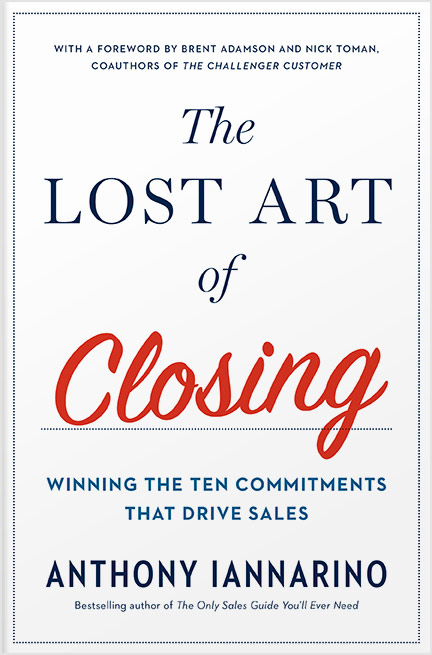Experts will tell you that time kills deals. But time doesn’t kill deals, especially if you are engaged in a complex sales, where your buyer doesn’t make the decision frequently enough to know how to make a good decision, and where the decision is vital to their future (i.e., strategic). When time passes and deals die, this is what kills them:
No Commitment to Change
You are going to engage with prospective clients who are more than willing to explore change with you, the second of the ten commitments you will find in The Lost Art of Closing: Winning the 10 Commitments That Drive Sales. The reason prospects are willing to engage in exploring change is because they aren’t required to commit to taking action. Instead, they get to discuss their challenges and opportunities so they can start to understand what they might need to do and what kind of changes may be necessary.No more pushy sales tactics. The Lost Art of Closing shows you how to proactively lead your customer and close your sales. 
The mistake many salespeople and their managers make is believing that they have an opportunity before the client has agreed they want to move forward with a conversation about change. At some point in a conversation where you are exploring change, you have to ask whether it makes sense to do something now and if your contact is ready to move forward. When you haven’t had a conversation about time kills deals moving forward, you didn’t lose the deal because of time. Setting aside the fact that you weren’t really working a deal, the reason you don’t have a deal is that your dream client didn’t commit to change.
No Commitment to the Next Step
When it feels like time is killing a deal, time is not to blame. Instead, you are the reason the deal is dying a slow, painful death.
Time isn’t the problem; a lack of a client commitment to move forward with whatever comes next in the process is the real culprit. It isn’t time; it is the lack of activity. Time is going to pass whether or not you are taking action, and while you can’t do anything about time (it will pass no matter what), you can do something about the activity. If you don’t want potential deals to die as time goes by, you need to acquire a commitment to take the next step—and your prospective client needs to keep that commitment.
The way to keep deals from stalling out and dying is by keeping the momentum by controlling the process, linking together the necessary commitments that allow you to keep the momentum. To do that, you must control the process.
Controlling the Process
Disclaimer: When I write “control the process,” I am not suggesting you try to control the client or control the outcome. Controlling the process doesn’t require that you use a hard sell or pressure them. If you have to pressure other people to take the action you believe will benefit them, you are not a good salesperson. The way we think about controlling the process is by recommending what comes next and ensuring the client understands how they benefit from taking the next step.
There is a rule that makes it easier to control the process. It’s called the Trading Value Rule. This rule is that you have to share the reason and the value proposition for the next meeting. If you can’t clearly make a compelling case for what comes next, you can’t expect your dream client to agree to the meeting or keep the commitment if they do agree. You must be able to convey how your prospective client benefits from taking the step. Because you help your clients produce better results, you know better than your client what should come next for companies that succeed in creating new and better outcomes. You struggle when you lose control.
Managing Nonlinearity
In The Lost Art, I wrote about nonlinearity. The methods described in that book assume that your deal may not take as straight and certain a path as your sales process suggests, or your theory about your client’s buying journey might suggest.No more pushy sales tactics. The Lost Art of Closing shows you how to proactively lead your customer and close your sales. 
A framework like the one in The Lost Art is a map providing you with the everyday conversations and commitments a prospect generally makes, but with the caveat that you may not follow the order they appear in the book (time, explore, change, collaborate, consensus, invest, review, resolve concerns, decide, and execute). Even though the list of commitments is useful, there are commitments you may need to gain in order to keep the momentum that doesn’t appear here. You may need to obtain the commitment to provide you with the data you need to assess your client’s current state. I would bundle that under the commitment, “collaborate,” but it may come earlier or later in a particular deal, for reasons that may only make sense in that specific deal.
Nobody’s Fault but Yours
The recognition that it is not time that kills deals, but a lack of activity is critical. The time only passes without movement for a couple of reasons, starting with the idea that you have an opportunity before your contacts agree they want to move forward to do something to improve their results.
If you leave meetings without acquiring the commitment to what comes next, you have created the circumstances that increase the odds that you have to chase your dream client across time and space, badgering them over voicemail and email. You have also created a gap between one meeting and the next, increasing the time between meetings, should you ever acquire another one with that particular client. The time isn’t a problem you can solve; you can only solve the problem of obtaining the next commitments.
If you don’t recognize the need to control the process or the necessity of trading enough value to justify the next meeting, you will likely see time as the obstacle, when in fact, you are the obstacle.
If you want to make time your ally, then link together the necessary commitments and spend more time with your contacts engaged in the process of change. The more time you spend with your client, the greater the likelihood you win their business. Time face to face is a competitive advantage. Time without any communication and with no real commitments will cause you to lose deals.











.jpg?width=768&height=994&name=salescall-planner-ebook-v3-1-cover%20(1).jpg)



Comments